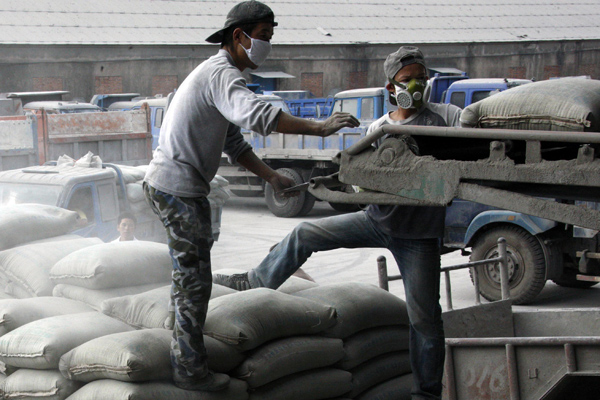 |
|
Workers offload cement bags at a factory in Huaibei, Anhui province. [Photo by Wu He/For China Daily] |
Merger of leading cement companies will likely concentrate the industry's capacities, according to the China Cement Association.
In a recent paper on the cement industry consolidation, the CCA informed the government departments concerned that by the end of 2020, more than 60 percent of the production capacity in the country would vest in the top 10 companies.
Qiao Longde, president of the CCA, said that the industry is mired in low efficiency and chaos because most cement factories are small and scattered, lacking in high technologies and management expertise.
"There are too many cement enterprises, which makes it very hard to utilize resources effectively," said Qiao.
China has more than 3,500 cement enterprises. The top 10 have only a combined 54 percent of the total production capacity. This has led to vicious competition and price wars.
The State Council issued a notice on the restructuring of the building materials industry in May, stipulating that the top ten cement clinker companies should account for 60 percent of the country's total output.
In August, the State-owned Assets Supervision and Administration Commission of the State Council approved the merger of China National Building Materials Group Corp and China National Materials Group Corp.
The new company, called China National Building Material Group Co Ltd, has total assets of 550 billion yuan ($82.5 billion), making it the largest building materials group in China. Its cement production capacity of cement clinker ranks among the biggest in the world.
Song Zhiping, chairman of China National Building Material Group Co Ltd, said that China's cement industry badly needs consolidation.
"The industry's capacity this year is around 3.5 billion metric tons while the sales have been around 2.4 billion tons in the recent two years. The capacity has exceeded demand by 30 percent. We need higher capacity concentration," said Song.
Another problem is that low-standard cement takes up too much of the output, said Song.
"The Mark 32.5 cement should be eliminated. Most of the countries in the world use Mark 42.5 cement and above. This is only to be achieved by eliminating outdated capacity," said Song.
Cement mark represents the material's strength. Higher strength signifies longer life or durability. In China, Mark 32.5 cement, which is of low strength, takes up 60 percent of the market.
Beijing-based NBMG Corp and JiDong Development Co Ltd based in Tangshan, Hebei province, the two largest cement enterprises in the Beijing-Tianjin-Hebei region, signed an agreement on asset and share merger in April.
In 2015, JiDong ranked fourth in production capacity in China and NBMG ninth. The merger, if pushed through, will result in a new company with a capacity of more than 110 million tons, giving it the third place in China.
